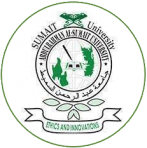UHUSIANO WA MOFU ZA NJEO KATIKA KITENZI CHA KITUMBATU NA KISWAHILI SANIFU
DOI:
https://doi.org/10.63104/suj.v.i.25Abstract
This article focuses on the field of Morphology in examining the relationship between morphemes that represent aspects in a verb structure of Standard Kiswahili and Kitumbatu (dialect) as well as identifying the impact that arises because of that relationship. This study highlights some of the verbs from Kiswahili Standard and Kitumbatu and examines them through their internal and external structures. The article identifies the similarities and differences between the Kiswahili and the Kitumbatu verbs due to their representation of the affixes (morphemes of aspects). Among the areas that appear to be the same are in the morphemes of present tense that are represented by the morph (-na-) in affirmative case. Differences are also seen in the morphemes of past tense in the status of affirmative. The study also identifies the effects of the similarities or variations of those morphemes of aspects. Among these are the effects of phonological processes emerging from various principles including the principle of vowel harmony. From this study we can conclude that there is an interrelation between Standard Kiswahili and Ktumbatu dialect, since there are similarities and even differences in the affixes (morphemes of aspects) in use.
Downloads
References
Crstal, D.(1997) A Dictionary of Linguistics and Phonetics (4th ed.). Oxford:Basil Blackwell.
Habwe. J na Karanja. P (2007) Misingi ya sarufi ya Kiswahili.Phoenix Publishers Ltd. Nairobi.
Kapinga, C (1983) Sarufi maumbo ya Kiswahili sanifu. TUKI, Dar es salaam.
Kipacha .A ( 2003 ) Lahaja Za Kiswahili OSW 303. Chuo Kikuu Huria. Dar es Salaam
Mgullu,R (1988) Uhakiki wa makala ya dhana ya mofu ,alomofu, na mofimo. Mulika na.20. Dar es salaam.
Massamba na wenzake (2001) Sarufi miundo ya Kiswahili Sanifu (SAMIKISA). Taasisi ya Uchunguzi wa Kiswahili, Chuo Kikuu cha Dar es Salaam.
Massamba na wenzake (2003) Sarufi maumbo ya Kiswahili Sanifu (SAMAKISA). Taasisi ya Uchunguzi wa Kiswahili, Chuo Kikuu cha Dar es Salaam.
Massamba, D.P.B (2002) Historia ya kiswahili 50 BK hadi 1500 BK. The Jom Kenyatta Foundation. Nairobi
Massamba, D.P.B (2004) Kiswahili cha Musoma: mwanzo wa lahaja nyingine?, journal of institute of Kiswahili Research, Vol. 9.TUKI
Martinet, A (1973) Morphonemics. New York
Mashaka H. (2017) Lulu za Isimujamii: Mtazamo wa Kisinkronia kwa Sekondari na Vyuo. Tridax Africa Company Limited. Tanzania.
https://www.researchgate.net/publication/286454770_Lahaja_Za_Kiswahili_OSW_
http://www.mwananchi.co.tz/swahilihub/makala/2655370-2658508885gy4/index.html

